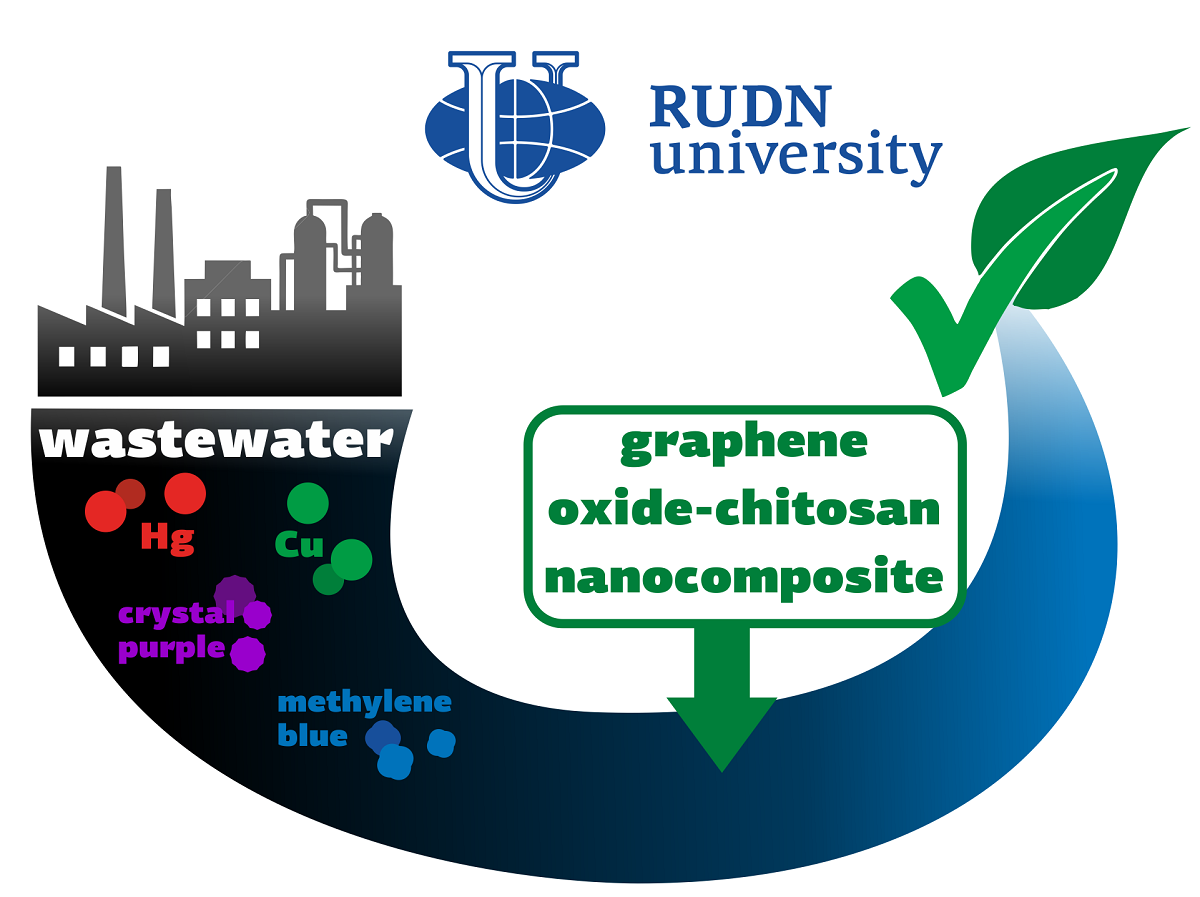RUDN University environmentalist has created a reusable "nano-sponge" for wastewater treatment

The discharge of organic and inorganic waste into wastewater is a serious threat to the environment and human health. Moreover, the combined effect of several pollutants may be stronger than their total harm. Therefore, tools are needed that would allow to get rid of several types of harmful substances at once. Existing solutions are mainly aimed at removing only organic or only inorganic compounds. A RUDN ecologist, together with colleagues from Korea and India, created a hybrid compound based on graphene and chitosan, which allows you to simultaneously remove inorganic (for example, mercury and copper) and organic (for example, methylene blue and crystal violet) pollutants from wastewater.
“Adsorbents are used to remove one chemical or several chemicals belonging to the same chemical class. However, such success has not been achieved in the removal of pollutants of different classes using adsorption. Researchers are faced with low adsorption rates and removal efficiencies. Therefore, it is necessary to synthesize a new adsorbent, since adsorption technology is needed in the future to remove several types of pollutants from wastewater,” Vinod Kumar, PhD, professor at RUDN University.
Ecologists have created a nanocomposite based on graphene oxide (a flat modification of graphite) and chitosan (a polysaccharide obtained from animal and fungal chitin). Ethylenediaminetetraacetic acid adds chemical activity to the new compound; it introduces functional groups into the nanocomposite, which determine its activity as an adsorbent. The structure and properties of the nanocomposite were determined by ecologists using X-ray diffraction, infrared spectroscopy, and other methods. Then the ecologists experimentally studied the adsorption activity of the nanocomposite.
One gram of the substance was able to absorb up to 324 mg of mercury, 130 mg of copper, 141 mg of methylene blue and 121 mg of crystal violet. Ecologists explained such a significant capacity by the fact that the nanocomposite contains many functional groups. Moreover, the “nano-sponge” can be washed and used again — after seven cycles of soaking and rinsing, the absorption efficiency has decreased by no more than 10%.
“Even in the presence of foreign metal ions, target metal ions are successfully adsorbed. Moreover, other metals are also well removed. The adsorbent also remained effective for several metal ions and dyes simultaneously. The created nanocomposite can retain its adsorption capacity for both inorganic and organic pollutants even after seven adsorption-desorption cycles. All this indicates that it can be promising in the treatment of a complex mixture of wastewater containing inorganic and organic pollutants,” Vinod Kumar, PhD, professor at RUDN University.
The results are published in the journal Chemosphere.
RUDN summarized the results of the scientific competition "Project Start: work of the science club ". Students of the Faculty of Physics, Mathematics and Natural Sciences have created a project for a managed queuing system using a neural network to redistribute resources between 5G segments. How to increase flexibility, make the network fast and inexpensive and reach more users — tell Gebrial Ibram Esam Zekri ("Fundamental Computer Science and Information Technology", Master's degree, II course) and Ksenia Leontieva ("Applied Mathematics and Computer Science", Master's degree, I course).
The National Demographic Report, 2023 Demographic Well-Being of Russian Regions (hereinafter - the National Demographic Report) was prepared by the scientific team of the Institute of Demographic Studies of the Federal Research Center of the Russian Academy of Sciences, the Vologda Scientific Center of the Russian Academy of Sciences, Peoples' Friendship University of Russia, the Center for Family and Demography of the Academy of Sciences of the Republic of Tatarstan, as well as with the participation of leading scientists from the Republic of Bashkortostan, Stavropol Krai, Volgograd, Ivanovo, Kaliningrad, Nizhny Novgorod, Sverdlovsk Oblasts and Khanty-Mansi Autonomous Okrug–Yugra.
RUDN summarized the results of the scientific competition "Project Start: work of the science club ". Students of the Faculty of Physics, Mathematics and Natural Sciences have created a project for a managed queuing system using a neural network to redistribute resources between 5G segments. How to increase flexibility, make the network fast and inexpensive and reach more users — tell Gebrial Ibram Esam Zekri ("Fundamental Computer Science and Information Technology", Master's degree, II course) and Ksenia Leontieva ("Applied Mathematics and Computer Science", Master's degree, I course).
What is your first association with the word “laboratory”? Flasks and beakers? Microscopes and centrifuges? Yes, many of us would answer the same way.
The National Demographic Report, 2023 Demographic Well-Being of Russian Regions (hereinafter - the National Demographic Report) was prepared by the scientific team of the Institute of Demographic Studies of the Federal Research Center of the Russian Academy of Sciences, the Vologda Scientific Center of the Russian Academy of Sciences, Peoples' Friendship University of Russia, the Center for Family and Demography of the Academy of Sciences of the Republic of Tatarstan, as well as with the participation of leading scientists from the Republic of Bashkortostan, Stavropol Krai, Volgograd, Ivanovo, Kaliningrad, Nizhny Novgorod, Sverdlovsk Oblasts and Khanty-Mansi Autonomous Okrug–Yugra.